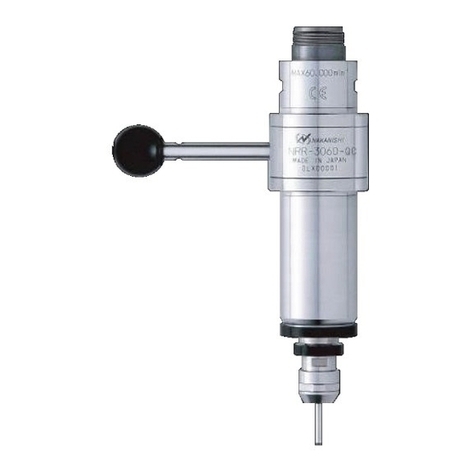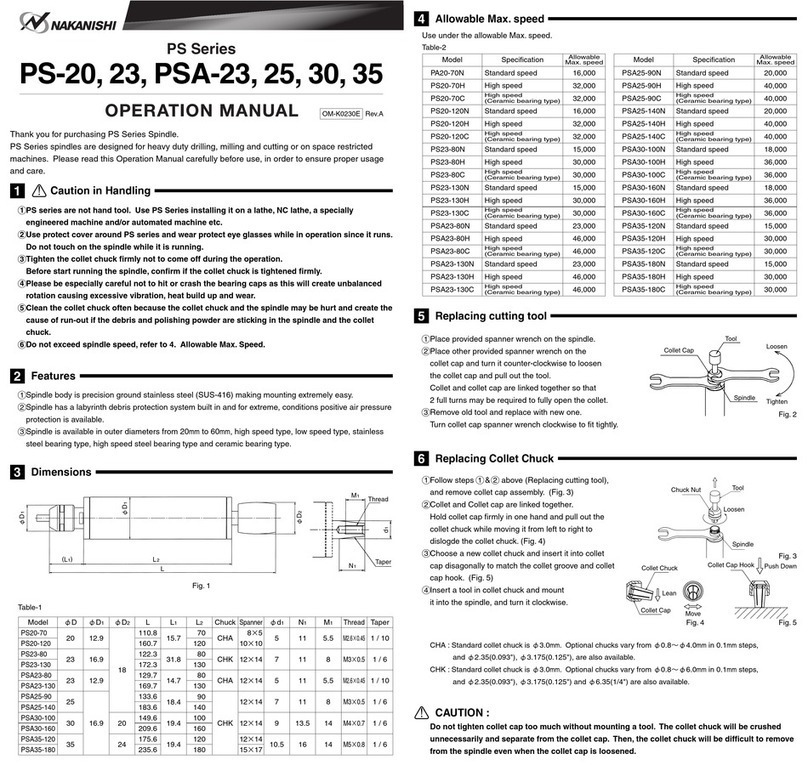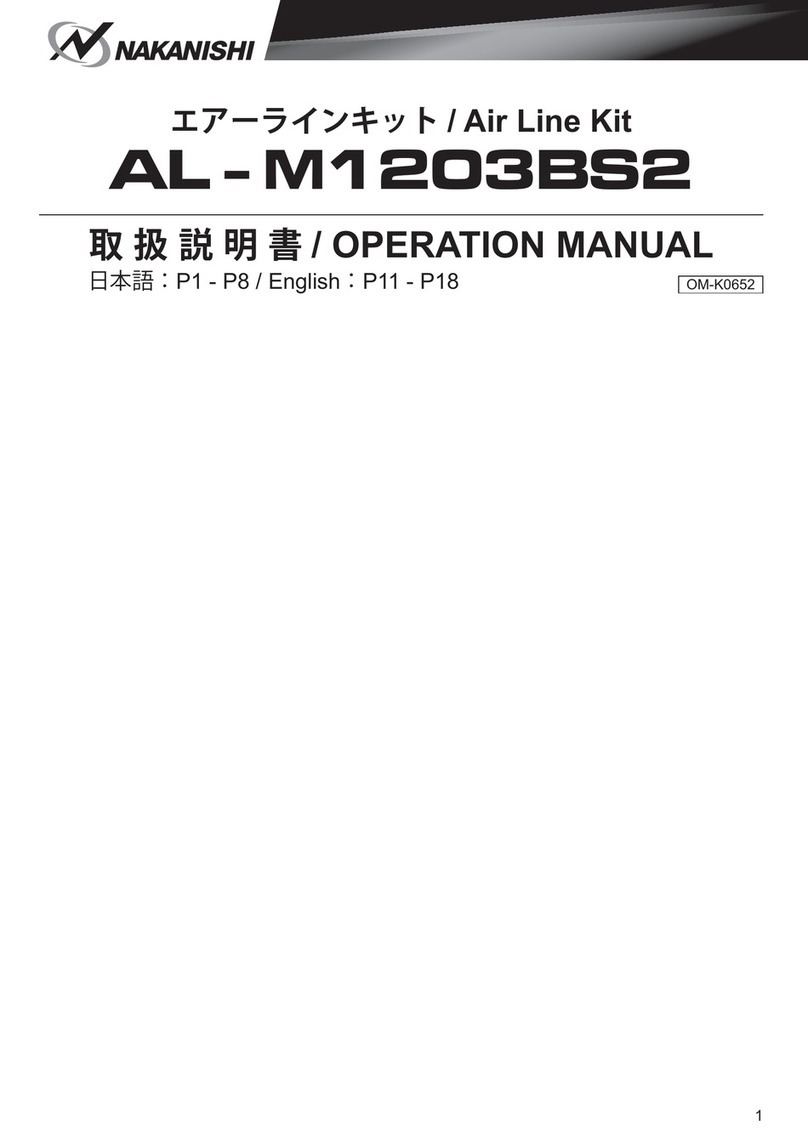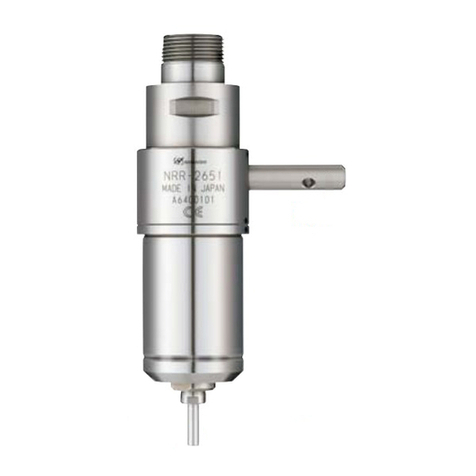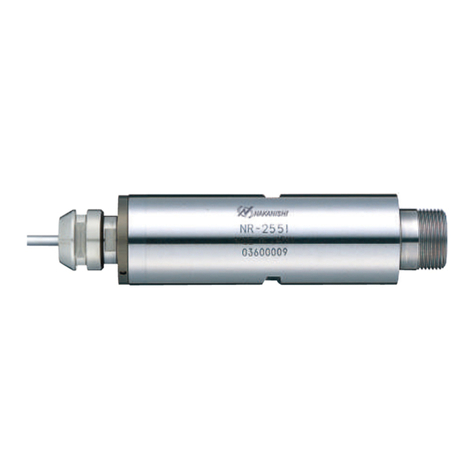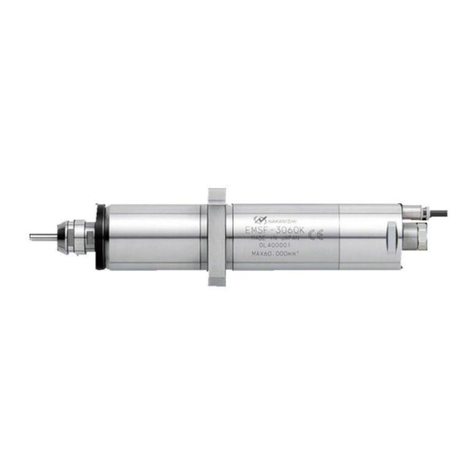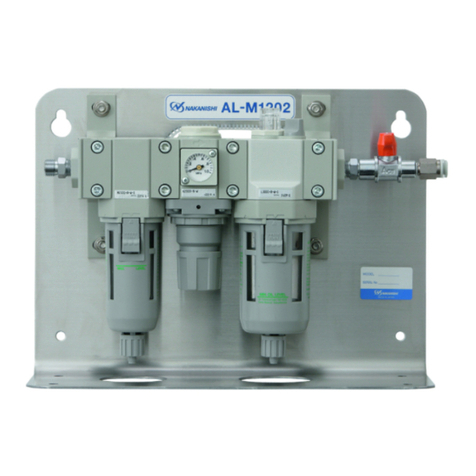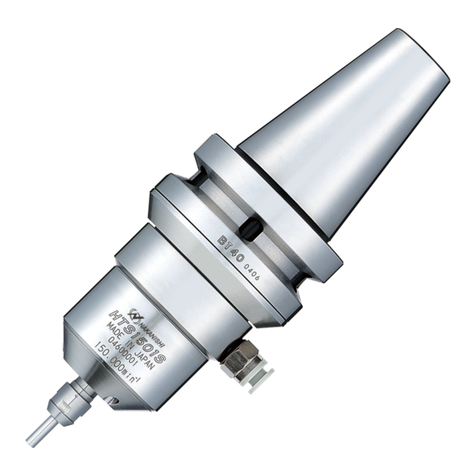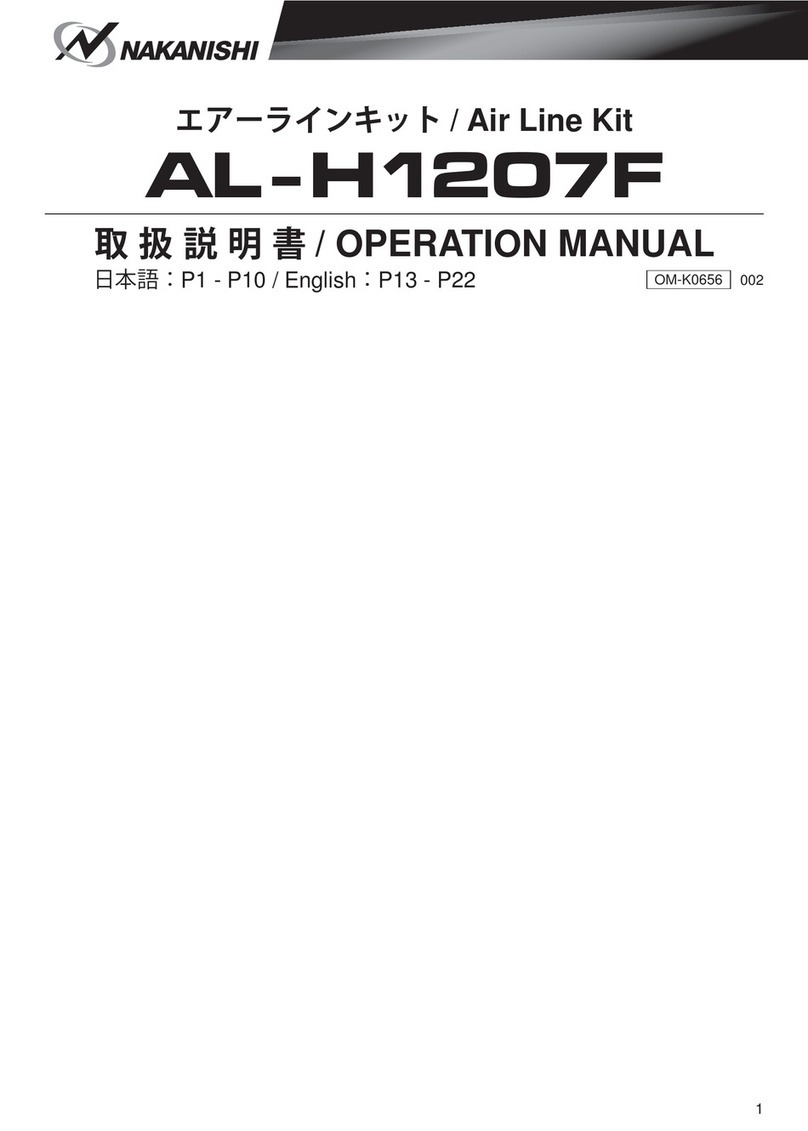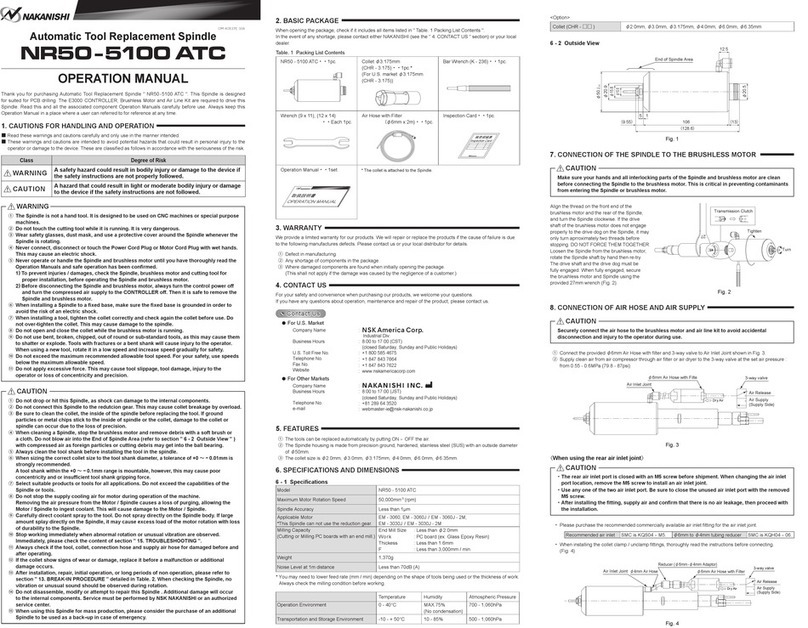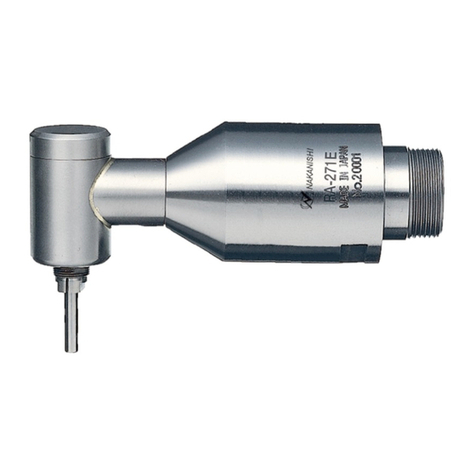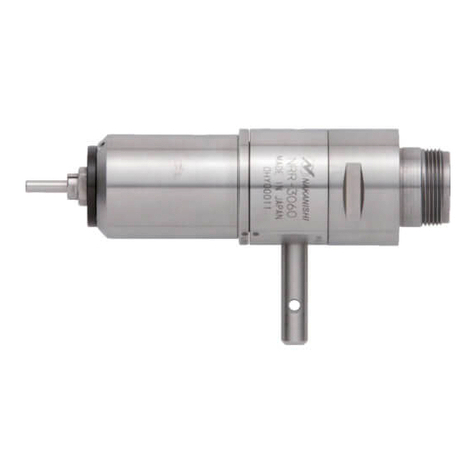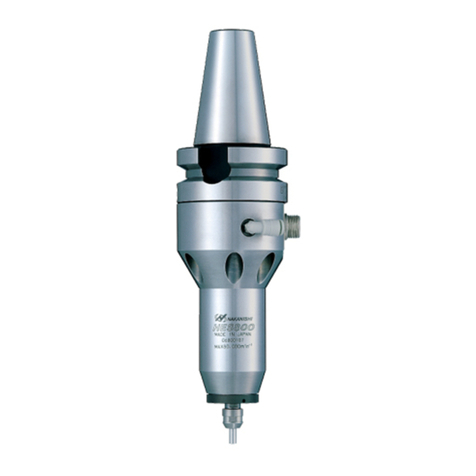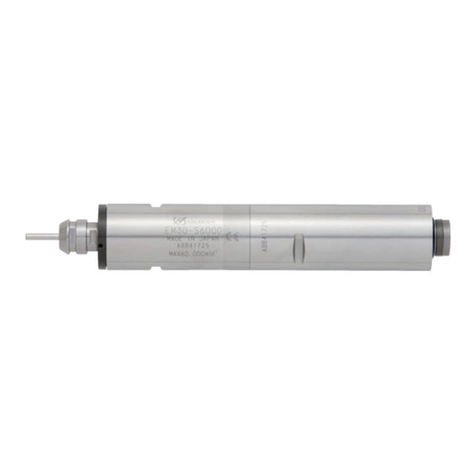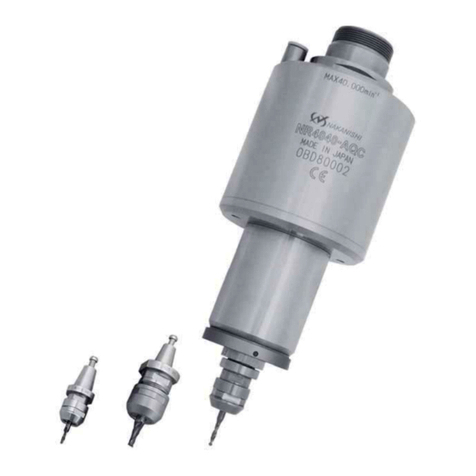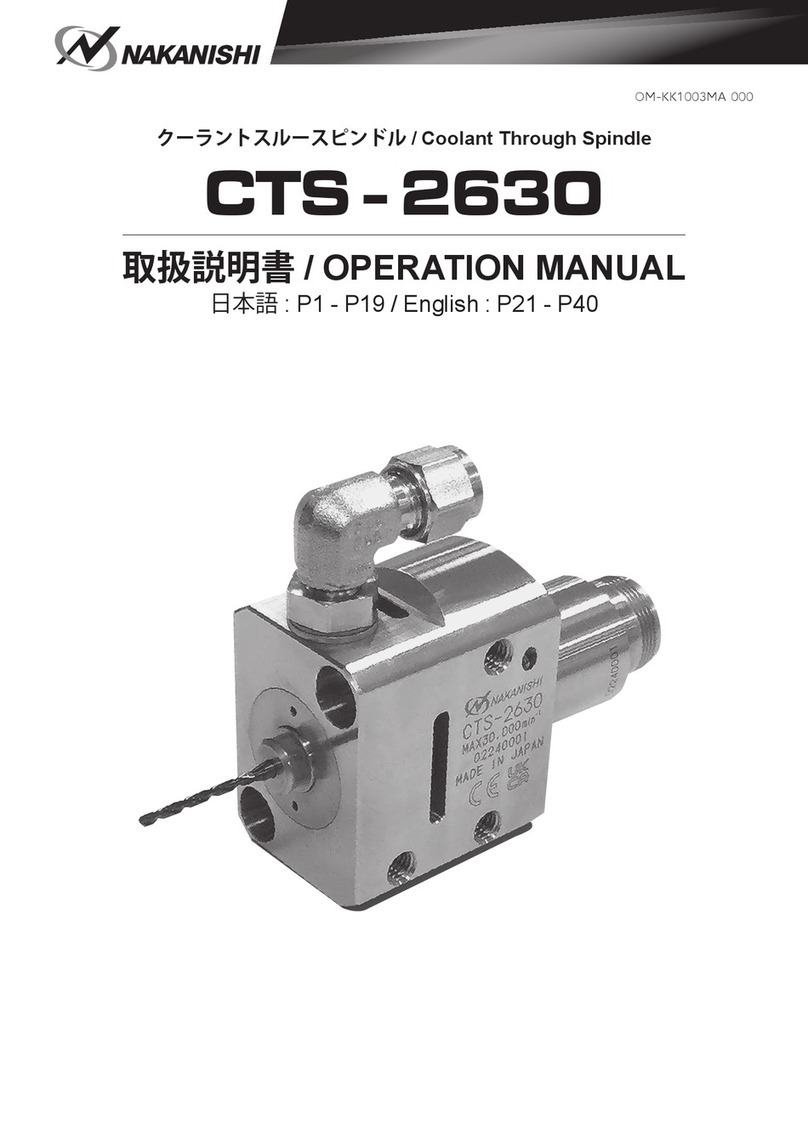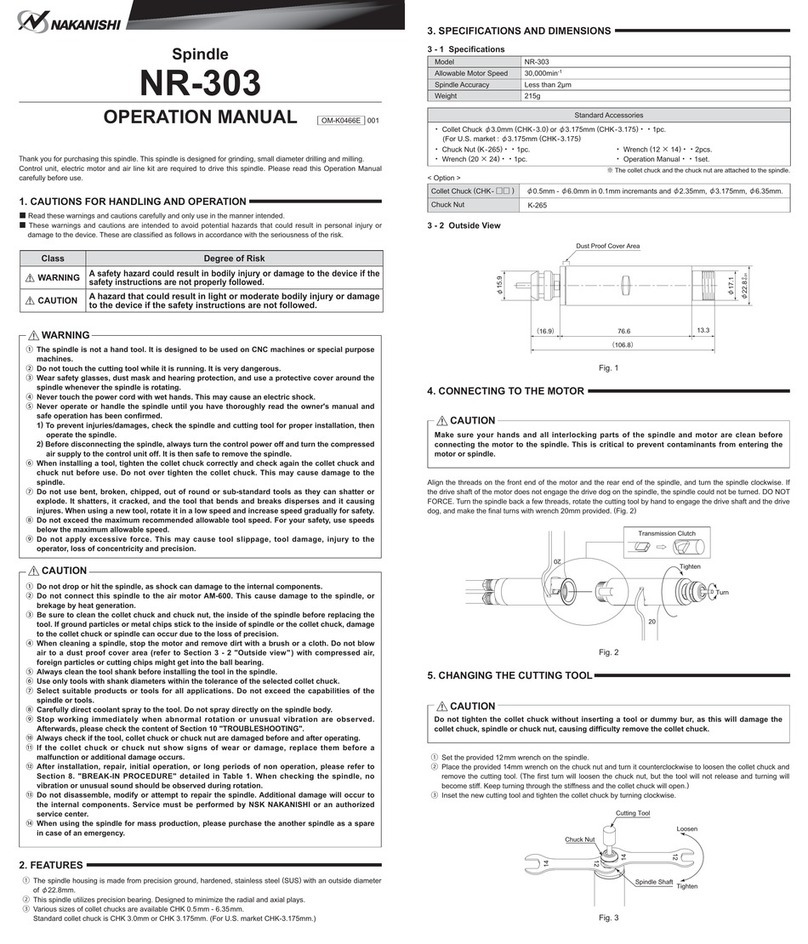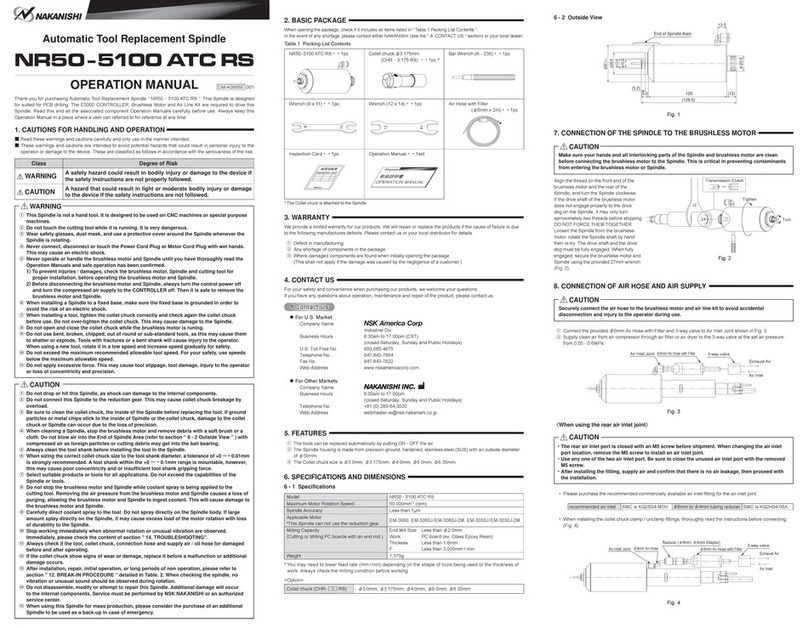
OPERATION MANUAL
Class Degree of Risk
WARNING
A safety hazard could result in bodily injury or damage to the device if the
safety instructions are not properly followed.
CAUTION A hazard that could result in light or moderate bodily injury or damage
to the device if the safety instructions are not followed.
Thank you for purchasing 90°Angle Spindle RAS - 101 / RAS - 151E. This spindle is designed for grinding, small
diameter drilling and milling.
The <E3000 CONTROLLER / E2530 Control Unit>, <Brushless Motor> or <Air Motor> and <Air Line Kit > are
rquired to drive this spindle. Read this Operation Manual carefully before use. Also read <E3000 CONTROLLER /
E2530 Control Unit>, <Brushless Motor> or <Air Motor> and <Air Line Kit> Operation Manuals.
OM-K0410E
90°Angle Spindle
RAS-101・RAS-151E
002
3. SPECIFICATIONS AND DIMENSIONS
3 - 1 Specification
Model RAS - 101 RAS - 151E
Maximum rotating
speed at the tool
For Air Motor 2,870min-1 7,200min-1
For Brushless Motor 7,490min-1 7,490min-1
Maximun Motor
Rotation Speed
For Air Motor 7,650min-1 19,000min-1
For Brushless Motor 20,000min-1 20,000min-1
Applicable Motor
For Air Motor AM - 300R / L, AM - 300RA / LA
AM - 310R / L, AM - 310RA / LA
AM - 3020R / L
AM - 3020RA / LA
For Brushless Motor EM25 - 5000 - 4M / 5M / 8M
EM25 - 5000 - J4 / J5 / J8
EM - 3060, EM - 3060J
EM - 3060J - 2M, EM - 3030J
EM - 3030J - 2M
Applicable Control Unit (For Brushless Motor)
E2530 Control Unit E3000 CONTROLLER
Spindle Accuracy Less than 2μm
Reduction Ratio 1 / 2.67
Weight 325g 413g
Noise Level at 1m distance Less than 70dB (A)
Loosen
14
12
Spindle Shaft
Chuck Nut
Tool
①Remove the tool according to the section
" 5. CHANGING THE TOOL " procedure
above and remove chuck nut assembly
(Fig. 5).
②The collet chuck and chuck nut are secured
by a groove in the collet chuck and a flange
in the chuck nut. To remove the collet chuck
hold the chuck nut in one hand and push
diagonally down on the collet chuck. The
collet chuck should be released (Fig. 6).
③To install the collet chuck, hold the collet
chuck at a slight angle, and insert it into the
chuck nut (Fig. 7).
Press the collet chuck in the chuck nut by
positioning the collet chuck in the chuck nut
and pressing down on flat surface (Fig. 6).
Be sure to fully engage the latch inside
the chuck nut into the groove on the collet
chucks outer circumference area (Fig. 8).
Fig. 5 Fig. 6
Groove
Latch Collet Chuck
Chuck Nut
Latch
Collet Chuck
Wrench Seat
Chuck Nut
Down
Fig. 7 Fig. 8
1. CAUTIONS FOR HANDLING AND OPERATION
■Read these warnings and cautions carefully and only use in the manner intended.
■These warnings and cautions are intended to avoid potential hazards that could result in personal injury or
damage to the device. These are classified as follows in accordance with the seriousness of the risk.
WARNING
①This spindle is not a hand tool. It is designed to be used on CNC machines or special purpose
machines.
②Do not touch the cutting tool while it is running. It is very dangerous.
③Wear safety glasses, dust mask and use a protective cover around the spindle whenever the
spindle is rotating.
④Never connect, disconnect or touch the Power Cord Plug and Motor Cord Connector with wet
hands. This may cause an electric shock.
⑤Never operate or handle the spindle until you have thoroughly read the owner's manual and
safe operation has been confirmed.
1) To prevent injuries / damages, check the spindle and cutting tool for proper installation,
before operating the spindle.
2) Before disconnecting the spindle, always turn the control power off and turn the compressed
air supply to the Control Unit off. Then it is safe to remove the spindle.
⑥When installing a spindle to a fixed base, make sure the fixed base is grounded in order to
avoid the risk of an electric shock.
⑦
When installing a tool, tighten the collet chuck correctly and check again the collet chuck and
chuck nut before use. Do not over-tighten the collet chuck. This may cause damage to the spindle.
⑧Do not use bent, broken, chipped, out of round or sub-standard tools as they may cause
shatter or explode. Tool with fractures or a bent shank will cause injury to the operator. When
using a new tool, rotate it in a low speed and increase speed gradually for safety.
⑨Do not exceed the maximum recommended allowable tool speed. For your safety, use speeds
below the maximum allowable speed.
⑩Do not apply excessive force. This may cause tool slippage, tool damage, injury to the operator
or loss of concentricity and precision.
CAUTION
①Do not ecxeed the maximum allowable motor speed 20,000min-1.
②Do not drop or hit this spindle, as shock can damage to the internal components.
③Be sure to clean the collet chuck and chuck nut, the inside of the spindle before replacing the
tool. If ground particles or metal chips stick to the inside of spindle or the collet chuck, damage
to the collet chuck or spindle can occur due to the loss of precision.
④When cleaning a spindle, stop the motor and remove debris with a soft brush or a cloth. Do not
blow air into the dust proof cover area (refer to section " 3 - 2 Outside view " ) with compressed
air as foreign particles or cutting debris may get into the ball bearing.
⑤Always clean the tool shank before installing the tool in the spindle.
⑥
When sizing the correct collet chuck size to the tool shank diameter, a tolerance of + 0 〜
-
0.01mm
is strongly recommended. A tool shank within the + 0 〜
-
0.1mm range is mountable, however,
this may cause poor concentricity and or insufficient tool shank gripping force.
⑦Select suitable products or tools for all applications. Do not exceed the capabilities of the
spindle or tools.
⑧Carefully direct coolant spray to the tool. Do not spray directly on the spindle body.
⑨Stop working immediately when abnormal rotation or unusual vibration are observed.
Afterwards, please check the content of section " 10 TROUBLESHOOTING ".
⑩Always check if the tool, collet chuck or chuck nut are damaged before and after operating.
⑪
If the collet chuck or chuck nut show signs of wear or damage, replace them before a malfunction
or additional damage occurs.
⑫After installation, repair, initial operation, or long periods of non operation, please refer to
section " 8. BREAK-IN PROCEDURE " detailed in Table 2. When checking the spindle, no
vibration or unusual sound should be observed during rotation.
⑬Do not disassemble, modify or attempt to repair this spindle. Additional damage will occur
to the internal components. Service must be performed by NSK NAKANISHI or an authorized
service center.
⑭When using this spindle for mass production, please purchase the another spindle as a spare
in case of an emergency.
2. FEATURES
①The spindle is capable of working on corners dificult to work or unit for working or unfit for working with straight
type spindle.
②The spindle housing is made from precision ground, hardened, stainless steel (SUS) with an outside diameter
of ȭ22.8mm (RAS-101)or ȭ30mm (RAS-151E).
③Various sizes of collet chucks are available CHK 0.5mm - 6.35mm. Standard collet chuck is CHK - 3.0mm or
CHK - 3.175mm. (For U.S. market CHK - 3.175mm.)
Standard Accessories
・Collet Chuck ȭ3.0mm (CHK-3.0) or ȭ3.175mm (CHK-3.175)・・1pc.
(For U.S. market ȭ3.175mm (CHK-3.175))
・Chuck Nut (K-265) ・・1pc.
・Wrench (12 ×14)・・2pcs.
・
Wrench
(22 ×27 : RAS-151E) or (20 ×24 : RAS-101)・・1pc.
・Operation Manual・・1set.
*The collet chuck and chuck nut are attached to the spindle.
Collet Chuck (CHK- □□ )ȭ0.5mm 〜ȭ6.0mm in 0.1mm increments and ȭ2.35mm, ȭ3.175mm, ȭ6.35mm
Chuck Nut K-265
<Option>
CAUTION
Use less than the maximum allowable motor speed 20,000min-1.
DO NOT exceed the maximum allowable motor speed 20,000min-1 for the spindle.
3 - 2 Outside view
Fig. 2 RAS-151E
4. CONNECTING THE SPINDLE TO THE MOTOR
Align the threads on the front end of the motor
and the rear end of the spindle, and turn the
spindle clockwise. If the drive shaft of the motor
does not engage the drive dog on the spindle,
the spindle could not be turned. DO NOT
FORCE. Turn the spindle back a few threads,
rotate the tool by hand to engage the drive
shaft and the drive dog, and make the final
turns with provided wrench.
Turn
Tighten
RAS-101
Transmisson Cluch (
-
)
RAS-151E
Transmisson Cluch (+)
Fig. 3
-0.01
0
Ǿ
22.8
-0.01
0
Ǿ
22.8
1475(16.9)1475(16.9)
47
-0.01
0
Ǿ
30
47
Ǿ15.9
Ǿ15.9
-0.01
0
Ǿ
23
Dust Proof Cover Area Dust Proof Cover Area
Fig. 1 RAS-101
5. CHANGING THE TOOL
①Set the provided 12mm wrench on the spindle.
②Place the provided 14mm wrench on the chuck nut and
turn it counterclockwise to loosen the collet chuck and
remove the tool. (The first turn will loosen the chuck nut,
but the tool will not release and turning will become stiff.
Keep turning through the stiffness and the collet chuck
will open.)
③Clean the collet chuck and chuck nut, then insert the new
tool and tighten the collet chuck by turning clockwise. Do
not overtighten.
12
12
14
Tool
Spindle Shaft
Loosen
Tighten
Chuck Nut
14
Fig. 4
CAUTION
・Make sure your hands and all interlocking parts of the spindle and motor are clean before
connecting the motor to the spindle. This is critical to prevent contaminants from entering the
motor or spindle.
・RAS-101 is drive (
-
) configuration clutch. The (
-
)drive spindles were designed to be used with (
-
)
drive motors and speed reducers.
Do not tighten the collet chuck without inserting a tool or dummy bur, as this will damage the collet
chuck, spindle or chuck nut, causing difficulty removing the collet chuck.
CAUTION
6. REPLACING THE COLLET CHUCK
When installing the collet chuck in the chuck nut, make sure to fully engage the latch inside the
chuck nut to the groove on the collet chucks outer circumference area. In addition, remember that
if the collet chuck is attached without being engaged with the latch of the chuck nut, the collet
chuck cannot be removed and this may cause damage to the collet chuck or the spindle.
CAUTION
Temperature Humidity
Atmospheric Pressure
Operation Environment 0 - 40°CMAX.75%
(No condensation) 700 - 1,060hPa
Transportation and Storage Environment -10 - + 50°C 10 - 85% 500 - 1,060hPa


